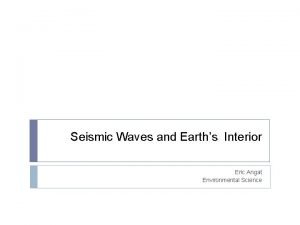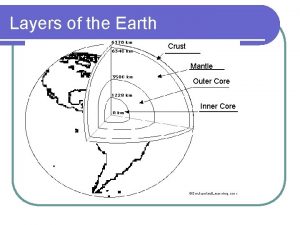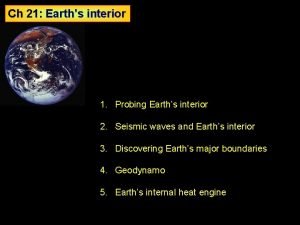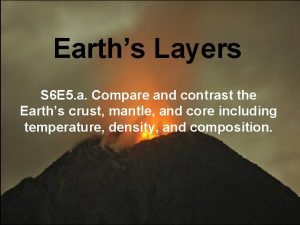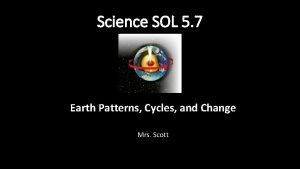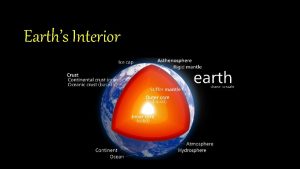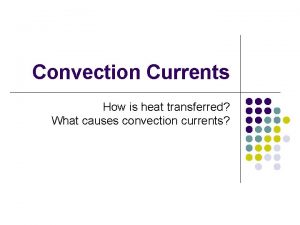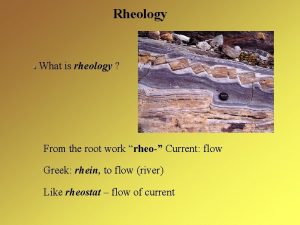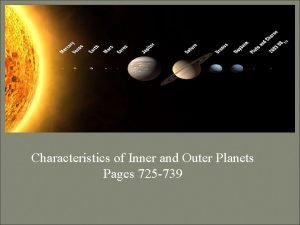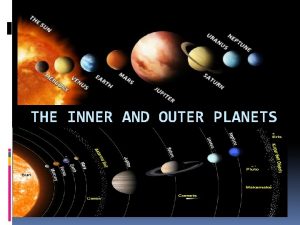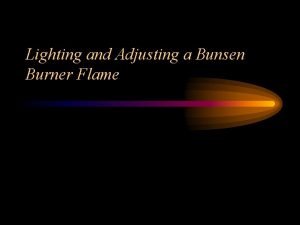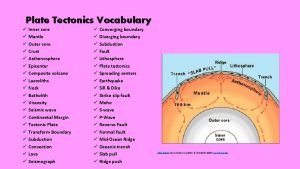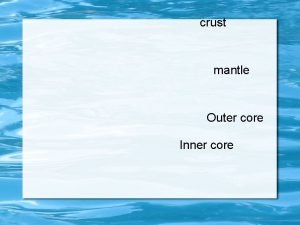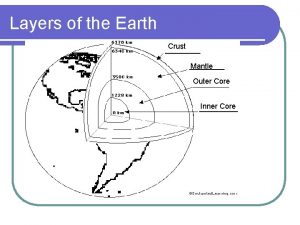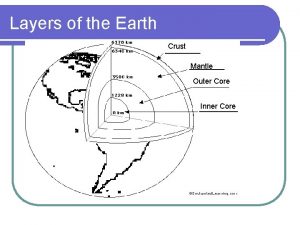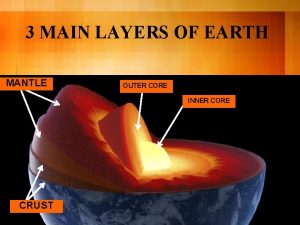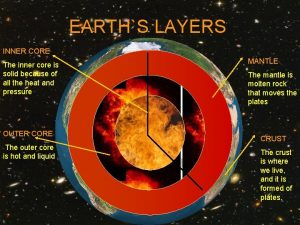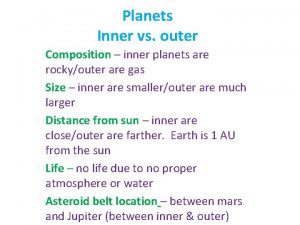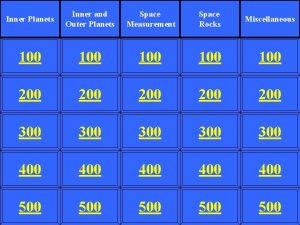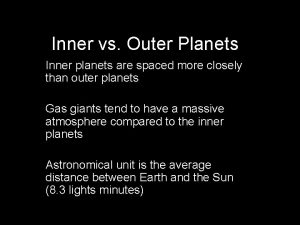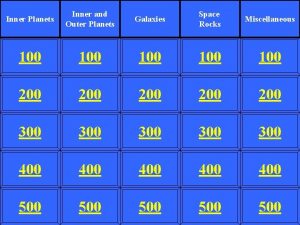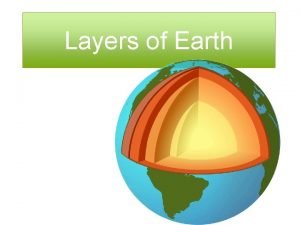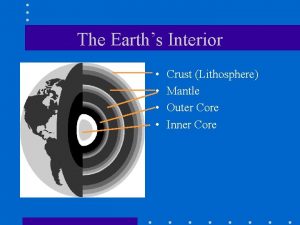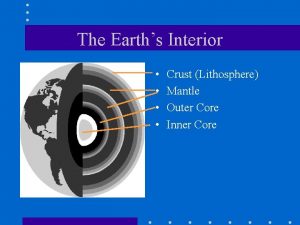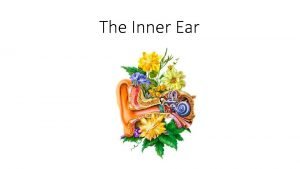Life Chemistry The EARTH Core inner outer Mantle




























- Slides: 28

Life Chemistry

The EARTH Core (inner, outer) Mantle Crust Lithosphere Hydrosphere Atmosphere Biosphere 93 % 7% 0. 03 % 0. 001 %

The elementary composition (%) Earth crust Human body O 49. 5 62. 4 Si 25. 7 - Al 7. 5 - Fe 4. 7 0. 005 H 0. 9 9. 8 P 0. 12 1. 0 C 0. 09 21. 1 S 0. 06 0. 16 N 0. 03 3. 1 - elementary composition of the human body is very different from that of lithosphere

Specific selection of some elements for the biological uses % in human body % in the Earth crust C 243 N 103 H 11 P 8 S 2. 7 O 1. 26 Fe 0. 001 Al 0. 000 13 Si 0. 000 04 - some chemical elements (C, H, N, O, . . . ) are "better" than others to make up molecules of living organisms

- most abundant elements of the Earth core: Fe, Ni - most abundant elements of the Earth crust: O, Si, Al, Fe - most abundant elements in living organisms: O, C, H, N - oxygen is the most abundant element both on the Earth surface and in human body

The atmosphere of the Earth Composition of the AIR Water vapour 1 -4% The dry air (by volume) Nitrogen Oxygen Argon Carbon dioxide All others 78 % 21 % 0. 93 % 0. 038 % only trace amounts

The geological development of the atmosphere • the loss of very light gases ( H 2 He CH 4 ) • the increase of O 2 (photolysis of water by the green plants) • fixation of CO 2 by photosynthesis 20 th centrury - slight increase of CO 2 burning of coal, gas, oil destruction of forests and phytoplankton 1900 current levels 0. 0296 % 0. 0385 % 296 ppm 385 ppm

The greenhouse effect CO 2 is a "greenhouse gas" - global warming

The oxygen cycle O 2 Animals, plants RESPIRATION CO 2 H 2 O We need per day: air water food Plants PHOTOLYSIS of H 2 O PHOTOSYNTHESIS 15 000 l [ 13. 5 kg ] 2 kg 1. 2 kg

Comparison of inspired and expired air Inspired Expired O 2 21 % 15 % CO 2 0. 03 % 5% N 2 78 % CO 2 is a waste product of respiration

Air pollution Emissions = the pollutants released into the environment Pollution natural industrial Natural sources Volcano eruptions Dust storms Fires Lightnings Biological decomposition dust NO CO 2 ash SO 2 ash CO 2 CO NO 2 H 2 S NH 3 CH 4 Dust particles water condensation CLOUDS, RAIN Impact of big meteor heavy dust pollution of atmosphere climate changes ( extinction of giant reptiles in mesozoic era ? )

Industrial sources The progress of civilization global air pollution (overcharging of the natural cycles of regeneration and detoxication) 1) 2) 3) 4) 5) 6) dust – ashes Sulphur dioxide ( SO 2 ) Nitrogen oxides ( NOx ) Carbon oxides ( CO 2 CO ) Toxic metals Organic compounds

Particulate matter - dust, ashes complex mixture of extremely small particles and liquid droplets sources: power plants, industrial and agriculture processes, transport, home effects: irritation of respiratory system contains adsorbed number of components: toxic metals, SO 2 cancerogenic hydrocarbons the size of particles is directly linked to their potential for causing health problems - smaller than 10 mm pass through the airways and enter the lung ! SMOG [ smoke + fog ] "London smog" HELP: industry, power plants - electrostatic precipitation home - no burning of coal and peat - using gas or oil, solar energy

Sulphur dioxide SO 2 main source: burning of soft coal ( 1 % S as sulphides of Fe ) Europe 1980: 40 000 tons of SO 2 ( ¾ bound to fly ash ) irritation of respiratory system, rhinitis, laryngitis SO 2 + H 2 O H 2 SO 3 sulphurous acid (weak acid) SO 2 sulphuric acid SO 3 + H 2 O H 2 SO 4 (strong acid) ACID RAIN p. H ~ 4 acidification of soil solution of minerals Al 3+ Pb 2+ Cu 2+. . . intoxication of plants and animals green plants: CO 2 x SO 2 competition destruction of photosynthetic enzymes (damage of pine forests)

Sulphur dioxide HELP: Power plants: SO 2 soft coal + Ca. CO 3 Ca. SO 4 ("gypsum") OR SO 2 Acid soil: + Ca(OH)2 Ca. SO 4 + Ca. CO 3 + Ca(OH)2 ("limestone") ("lime water")

Nitrogen oxides NO NO 2 NOx limit: 0. 1 mg / m 3 brown haze sources: motor vehicles, power plants, chemical industry secondary pollutants: NO 2 sun light OZONE ( O 3 ) PAN = peroxyacylnitrates NO + O Photochemical smog ( "Los Angeles – type" smog ) O 2 + O O 3 + hydrocarbons aldehydes (car exhausts) + NO 2 PAN very irritating to eyes and respiratory system

"London – type" smog combustion of coal = smoke + fog emission of sulphur dioxide ( SO 2 ) and dust + mixed with FOG "Los Angeles – type" smog dry air + sunny days + NOx + volatile organic gases (emitted by automobiles) = photochemical smog

Carbon dioxide CO 2 colorless, odorless gas "overproduction" sources: burning of fossil fuels air: 0. 038 % higher levels stimulate breathing long time respiration of 5 % CO 2 respiration troubles > 15 % DEATH Danger: old mines, caves, wine cellars (heavier than air it tends to go down) Carbon monoxide CO colorless, odorless gas sources: car exhausts, incomplete burning (smouldering) local street pollution – dangerous level: 10 ppm / 8 hours TOXIC: very high affinity to HEMOGLOBIN 35 ppm / 1 hour carbonylhemoglobin impaired ability of the blood to transport O 2 oxygen deprivation drowsiness unconsciousness DEATH

Toxic heavy metals Lead Pb - tetraethyllead was used as antiknock agent in gasoline (organometallic compound) Pb (CH 2 CH 3)4 neurotoxic Pb. O (lead oxide aerosol) deposition in the vicinity of highways toxic effects of inorganic lead compounds: impaired heme synthesis anemia Toxic metals aerosol As, Pb, Cd, Hg, . . . oxides bound to ash particulate matter - source: power plants ( COAL ! ), smelters - general toxicity – decrease of vitality

Organic compounds Hydrocarbons – motor vehicles, industry, cigarette smoke ( TAR ) - carcinogens, precursors to PAN Freons - hydrocarbons with hydrogen atoms substituated by F, Cl = chlorofluorocarbons ( CFCs ) - in older refrigeration and air-conditioning systems - effect: destroying the ozone layer in the stratosphere

Indoor air pollution Respiration CO 2 ( H 2 O) Digestion (intestinal bacteria) H 2 S Gas stove CO 2 CO indole ( H 2 O) Tobacco smoke TAR (cancerogens) Formaldehyde Radon Rn HCHO nicotine - released from foamed insulation tapestry plywood adhesives - radioactive gas - radon from natural sources can accumulate in buildings 222 86 Rn 4 2 He + 218 84 Po

~ 60 % of the body weight Water and Human body intracellular ~ 40 % extracellular ~ 20 % PLASMA 5% interstitial fluid 15 % - a very complex solution of inorganic & organic components Phosphates Proteins K+ Na+ Mg 2+ Na+ Cl- Na+ K+ Ca 2+ HCO 3 - Mg 2+ Phosphates K+ Na+/K+ pump ( = Na+/K+ -ATPase )

Blood plasma ( extracellular fluid ) Cell fluid (cytosol) ( intracellular fluid )

Human blood plasma mmol/l Na+ 132 – 145 K+ 3. 8 - 5. 2 Ca* 2. 1 – 2. 6 Mg 2+ 0. 8 – 1. 1 Cl- 97 – 108 HCO 3 - 22 – 26 Phosphates HPO 42 - + H 2 PO 4 - 0. 6 – 1. 6 p. H = 7. 36 – 7. 44 * Ca "total Ca" Ca 2+ "ionized" is about ½ of "total" ~ 1. 2 mmol/l

Water balance Intake: ~ 1. 5 - 2. 0 l / day metabolic water (produced in human body by oxidation of food) 0. 3 – 0. 5 l /day Resorption: stomach, small intestine, LARGE INTESTINE Secretion: Excretion: Saliva Stomach Bile Pancreas Small intestine 1 500 ml / day 2 500 700 3 000 Urine 60 % Skin 20 % (perspiration) Lungs 15 % Faeces 5 % 8 200 ml /day

Water in nature Hardness of water: Temporary hardness: Boiling: technical problems – deposits after boiling cause = Ca(HCO 3)2 soluble in water Ca. CO 3 + CO 2 + H 2 O Softening water in water stations: Ca(HCO 3)2 + Ca(OH)2 Permanent hardness: softening: 2 Ca. CO 3 + 2 H 2 O cause = Ca. Cl 2 Ca. SO 4. . . Ca. SO 4 + Na 2 CO 3 Ca. CO 3 + Na 2 SO 4

Biological pollution of water urine, excrements, dead bodies BACTERIAL decomposition (most efficiently by aerobic bacteria) I. organic compounds: UREA, proteins, peptides II. NH 3 III. NO 2 - markers of RECENT pollution ammonia NO 3 - - final decomposition products - good for plant nutrition EUTROPHICATION of water - fertilizers, phosphates (compounds of N, P)

The bioelements (summary) 1) Principal bioelements: O, C, N, H, P, S (biomolecules: proteins, nucleic acids, lipids, saccharides) 2) Water and ions ( H 2 O ) Na+, K+, Mg 2+, Ca 2+, Cl-, ( HCO 3 - , phosphates) 3) Mineral constituents of bones and teeth Ca (Mg, Na) PO 43 - CO 32 - ( F- Cl- ) 4) Microelements (trace elements) Fe, Cu, Co, Zn, I, F, Se, . . . ----------------------------5) Contamination (intoxication): Hg, Al, . . .
 Crust outer core inner core mantle
Crust outer core inner core mantle The brittle, rocky outer layer of earth
The brittle, rocky outer layer of earth The strong lower part of the mantle
The strong lower part of the mantle Inner defender examples
Inner defender examples Seismic waves
Seismic waves Crust mantle core
Crust mantle core Mechanical layers of the earth
Mechanical layers of the earth The 2 types of crust
The 2 types of crust Core mantle crust
Core mantle crust Core crust mantle
Core crust mantle Layers of earth crust
Layers of earth crust What best describes the mantle of earth
What best describes the mantle of earth Earth mantle
Earth mantle What causes convection currents in the mantle
What causes convection currents in the mantle Earth's mantle
Earth's mantle What are terrestrial planets made of
What are terrestrial planets made of Differential association example
Differential association example Inner outer planets venn diagram
Inner outer planets venn diagram Inner and outer sphere mechanism
Inner and outer sphere mechanism Explain how physical beauty differs from inner beauty
Explain how physical beauty differs from inner beauty Characteristics of the planets
Characteristics of the planets Inner and outer forces
Inner and outer forces What separates the inner and outer planets
What separates the inner and outer planets My very excited mother just served us nachos
My very excited mother just served us nachos What separates the inner planets and outer planets
What separates the inner planets and outer planets Lighting a bunsen burner
Lighting a bunsen burner Proper protractor orientation
Proper protractor orientation Inner and outer scale of protractor
Inner and outer scale of protractor What separates the inner planets and outer planets
What separates the inner planets and outer planets




